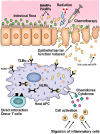Pathophysiology of GvHD and Other HSCT-Related Major Complications
- PMID: 28373870
- PMCID: PMC5357769
- DOI: 10.3389/fimmu.2017.00079
Pathophysiology of GvHD and Other HSCT-Related Major Complications
Abstract
For over 60 years, hematopoietic stem cell transplantation has been the major curative therapy for several hematological and genetic disorders, but its efficacy is limited by the secondary disease called graft versus host disease (GvHD). Huge advances have been made in successful transplantation in order to improve patient quality of life, and yet, complete success is hard to achieve. This review assimilates recent updates on pathophysiology of GvHD, prophylaxis and treatment of GvHD-related complications, and advances in the potential treatment of GvHD.
Keywords: T cells; graft versus host disease; haematopoietic stem cell transplantation; pathophysiology; prophylaxis.
Figures



References
-
- Billingham RE. The biology of graft-versus-host reactions. Harvey Lect (1966) 62:21–78. - PubMed
-
- Kernan NA, Collins NH, Juliano L, Cartagena T, Dupont B, O’Reilly RJ. Clonable T lymphocytes in T cell-depleted bone marrow transplants correlate with development of graft-v-host disease. Blood (1986) 68(3):770–3. - PubMed
-
- Martin PJ, Schoch G, Fisher L, Byers V, Anasetti C, Appelbaum FR, et al. A retrospective analysis of therapy for acute graft-versus-host disease: initial treatment. Blood (1990) 76(8):1464–72. - PubMed
-
- Filipovich AH, Weisdorf D, Pavletic S, Socie G, Wingard JR, Lee SJ, et al. National Institutes of Health consensus development project on criteria for clinical trials in chronic graft-versus-host disease: I. Diagnosis and staging working group report. Biol Blood Marrow Transplant (2005) 11(12):945–56.10.1016/j.bbmt.2005.09.004 - DOI - PubMed
Publication types
LinkOut - more resources
Full Text Sources
Other Literature Sources

